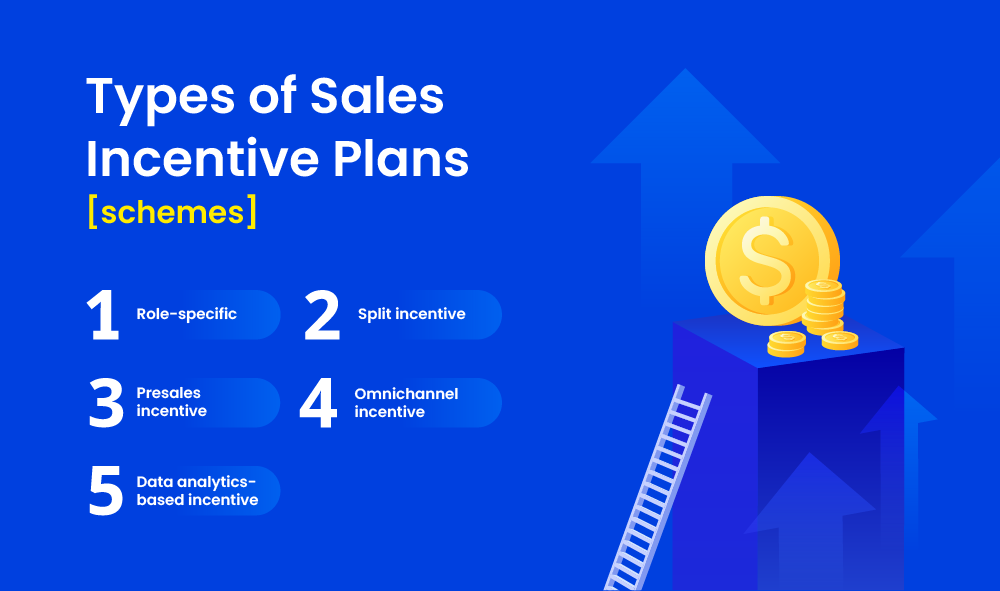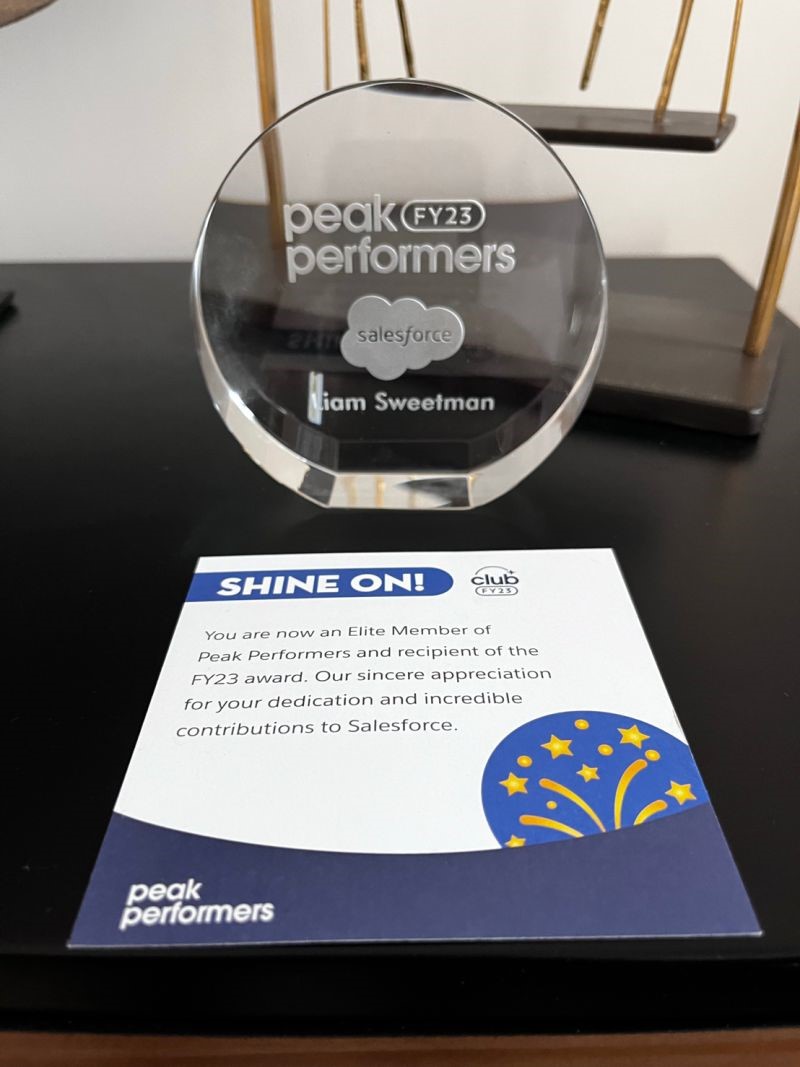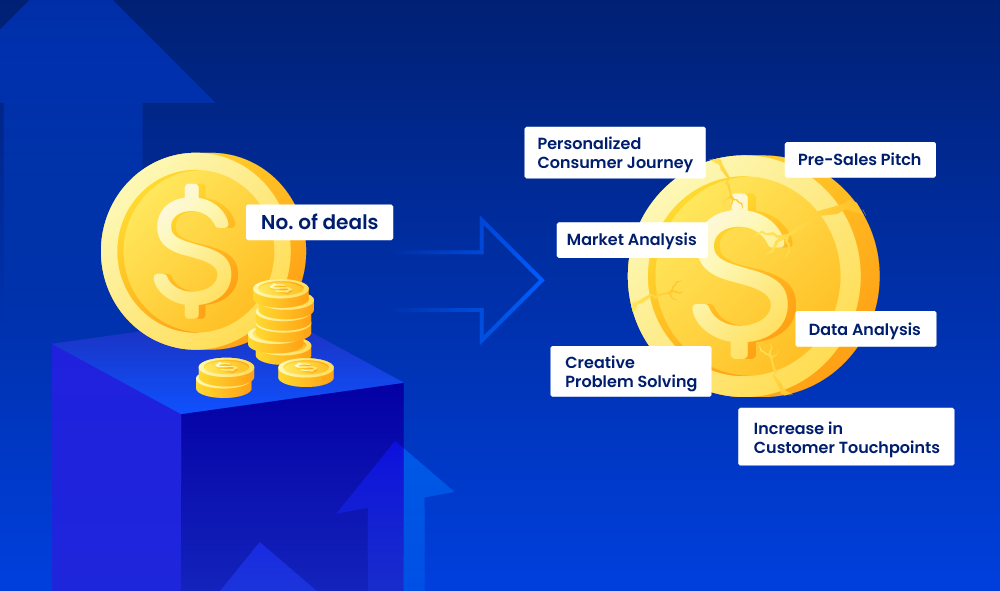Michael Scott (from the sitcom – The Office), the best salesman of the year (twice) and the most unassumed manager has great sales instincts. In fact, through his actions, he incentivized his sales team to solve vague buyer issues and close deals. Ultimately, his branch emerged as the most profitable one.

While leading by example is a great way to encourage your sales team, it seldom works when the organization is vast, and the clients come from varied backgrounds with different needs. This is why a well-designed sales incentive plan is crucial to help your salespeople align their hearts with the organization’s goals.
Well, what makes a sales incentive plan a great one? Is there a way to hit the goldmine? To understand this, let’s deep dive into the mechanics of it.
What Is a Sales Incentive Plan?
A sales incentive plan is any form of reward structured in the best interests of the sales representatives to help them realize their highest potential. It equips them to keep up with all the highs and lows that come with their job and boosts their morale to achieve targets.
Why Is a Sales Incentive Plan Necessary?
In sales, many times, despite the best efforts of the salesperson, the outcome may not be favorable. This uncertainty often leads to demotivation, disinterest in pursuing prospects, or low employee productivity.
Therefore, along with a great work culture and a positive work environment, an effective sales incentive plan goes a long way in bringing back enthusiasm.
According to an IRF (Incentive Research Foundation) study, around 50% of the employees considered recognition a whole experience rather than just a reward. This proves that employees are motivated by various non-monetary factors and the implications of the actual incentive itself.
A sales incentive plan provides ground to curate a holistic approach to incentivizing your sales team. It’s also an opportunity for sales managers and leaders to understand team dynamics and individual motivations.
The Difference Between a Sales Incentive Plan and a Sales Incentive Structure
In a broader sense, the sales incentive structure is a part of the sales incentive planning process. Sales incentive planning comprises the complete strategy, objectives, performance metrics, targets, type of incentive, and exceptions.
It considers the sales revenue, base pay, variables, tax implications, weightage of each performance metric, incentive rate, etc.
For ex, a straightforward commission-based sales incentive structure would be:
Incentive = Sales x Commission rate
i.e if Sales = $100,000 and Commission rate = 5% then,
Incentive = $100,000 x 0.05 =$5000
Key Points to Remember Before Creating a Sales Incentive Plan
1. Understand the objectives
The first step is to realize the need to create a sales incentive plan and point out the objectives. The objectives must be clear and achievable. A good sales team doesn’t need many objectives in their incentive plan.
Make sure your objectives are:
- Measurable – a proper system to track the different parameters of the incentive plan.
- Realistic – setting humane goals is another important aspect of a successful incentive plan.
- Countable – the fewer the objectives, the better the plan’s impact. Too many objectives might put the sales team in unwanted chaos. An efficient sales incentive plan would have around 3-4 objectives at most.
- Align the objectives with the organization’s overall goal – it is imperative that the objectives be in sync with the org’s vision and mission.
2. Talk to your team
Each sales team is different. Motivating factors vary based on the company culture, the products sold, each salesperson’s approach to their job, and various other things. Therefore, knowing your team in and out goes a long way in creating a successful sales incentive plan.
Speak to individual team members and understand what motivates them to pursue sales. Have regular meetings with the team to figure out the collaborative dynamics. Finally, find common ground and set objectives and rewards to benefit each individual and the team.
3. Finalize realistic metric
The Sales team cannot be expected to match extensive quotas within strict periods just for an incentive. This will, in turn, defeat the purpose of setting up a sales incentive plan in the first place. The idea is to help individuals become their best version while achieving the company’s goals.
Set up efficient metrics like the number of sales conversions, customer engagement efforts, team player, out-of-the-box problem solving, etc. Measuring performance with these also helps identify areas for improvement.
4. Pick the rewards accordingly
There are two types of rewards: Monetary and non-monetary.
Monetary incentives | Non-Monetary incentives |
Base pay + Variable | Personalized giveaways or mementos |
Cash rewards | Flexible working options |
Gift cards from popular stores | Offer courses to help them grow their prospects |
All-paid staycation weekend with the family. | An extra paid time off |
Retention bonus | Provide testimonials on LinkedIn or other professional sites. |
Piece-rate pay – Employees are paid on completion of each work item. | Provide networking opportunities with the senior ups |
Offer resourceful gadgets |
Non-monetary rewards are becoming increasingly popular today, especially with remote work taking a foothold in the corporate scene. A study showed companies in the US roughly invested $90 billion in non-monetary incentives.
Non-monetary rewards are subjective to each sales team, so picking out the right one might be a little tricky. However, the bright side is that you can get super creative and provide your employees with the best work culture.
5. Reward at the right time
Just like the saying “hit when the iron is hot” goes, setting up a whole plan and not incentivizing your team at the right time fails to deliver the effectiveness of the sales incentive plan.
When the team has stuck to their part of the deal, make sure you stick to yours and provide them with the recognition they deserve. Whether appreciating them on a group chat or approving an incentive for the quarter, getting things done on time is an integral part of the sales incentive framework.
6. Evaluate and repeat
A generic reward program might not yield the best results each time. Roll out the plan slowly and keep a record of the things that worked out for the team. Evaluate the framework and make changes accordingly.
For example, let’s say a company sells cars, and the sales team falls short of achieving the previous target of 40 cars per quarter and loses the incentive. Analyze the reason behind this and configure the sales incentive structure to help the sales team perform better.
Remember that the ultimate goal is to motivate and create a productive space for your sales team.
Now that we know which key points to remember before structuring out a sales incentive plan, let’s have a look at what benefits will this plan bring us.
Benefits of a Sales Incentive Plan
1. A comprehensive approach to driving sales performance
Motivation factors vary from person to person. A survey found that 65% of employees preferred non-monetary incentives and agreed that they are remembered for more extended periods. Good sales performance can be achieved with a systematic and well-addressed sales incentive plan suitable for everybody on the team.
2. Healthy work culture
Aligning an organization’s purpose with employee goals is one of the critical requirements while creating a sales incentive plan. With an effective commission plan, salespeople are rightly credited for their work. This promotes a healthy work culture at the company.
3. Top-talent retention
Top-performing employees are essential to any company. Attractive Incentive plans pave the way to retaining excellent sales reps. Long-term incentives, like company shares, encourage the top talents to extend their time in any organization.
4. Customer requirements forecasting
One of the main goals of any company is to meet its customer requirements. Therefore, a sales incentive plan always incorporates it as an objective. This fosters customer engagement, which helps predict customer requirements and better understand the market.
5. Employee upskilling
While sales incentive plans are crafted to motivate sales professionals and reach specific targets, they also ignite an intrinsic need to be better among the sales reps. This prompts the sales professionals to upskill themselves and perform better, resulting in a productive workforce.
Types of Sales Incentive Plans [schemes]

1. Role-Specific
In today’s competitive market, any company’s products are expected to be woven around the technicalities of the consumer’s ask rather than the other way around.
Post-purchase add-ons, upgrades, and tier plans work only if the product is customizable and scalable in the first place.
Therefore, sales reps need to understand the nuances of the specific industry and align the product offerings with the customer’s needs. They need to have expertise in the field they are selling into. This is where role-specific incentives can be impactful.
For example, when a new car is launched, the sales team needs a technical expert to understand how each part contributes to the best driving experience.
This customer success professional gathers customer feedback and expectations and relays them to the sales.
The sales reps and SDRs constantly keep in touch with prospects and personalize customer journeys.
A strategist should advise on the best time to launch the product and key points to mention while selling the automobile to close most deals.
All roles in the above sales process have unique responsibilities that impact the cycle. It’s crucial to incentivize each role accordingly.
It is important to note that Sales reps and SDRs are still the first line of a salesforce, and other roles contributing to sales revenue should be rewarded based on their helpful expertise.
2. Split incentive
This incentive plan focuses on rewarding the whole team rather than the individuals. It improves team spirit, coordination, and innovation while garnering an equal amount of work from each teammate.
In sales, scenarios arise wherein professionals from various locations, designations, and expertise must come together to tackle a complexity. Splitting incentives equally among everyone keeps everybody highly motivated, and results in their best work put forward.
Since this involves people coming together from different teams, cross-functional collaboration nourishes skills like teamwork, effective communication, critical thinking, and competence.
Sales managers should align responsibilities with team members’ strengths and communicate performance metrics and incentives.
3. Presales incentive
The more complex the product is, the longer the sales cycle gets. Especially if the consumer has a vast user base and multiple stakeholders are involved in the buying process.
Let’s consider an example.
A fintech company is looking for a feasible CRM solution to integrate with its software. They must consider several factors, like the CRM’s scalability, integration ability, ease of use, customer support quality, customization capability, etc.
Since this would be a massive purchase for the company, it is natural for them to consider all the available CRMs in the market before making the right decision.
The pre-sale phase might extend for as long as 3 – 6 months. Sales professionals might get demotivated by pursuing the same prospect without guaranteeing an actual deal in the near sight.
In this timestamp, sales reps must conduct market research to tailor their pitch and stay ahead of competitors.
Pre-sales incentives keep employees’ spirits high during this long, uneven phase and help them break down long-term goals into short-term, achievable ones.
A combination of SPIFF’s [Sales Performance incentive funds] and long-term incentives is the apt way to handle a pre-sales incentive plan.
4. Omnichannel incentive
Companies with extensive omnichannel communication manage to retain 89% of their customers.
The omnichannel era has begun, and a maximum number of unique touchpoints is the need of the hour. Customer retention is at the root of incentivizing omnichannel efforts. Salespeople must augment their efforts and leverage digitization to stay on top of their game.
The tricky part is maintaining a fine line between keeping your customers informed and spamming them with creative advances.
These measured efforts usually require going out of their usual scope of work, especially since these are recent advances.
Hence, incentivizing these efforts helps gradually make omnichannel communication a standard practice in sales.
5. Data analytics-based incentive
Dynamic business landscapes pose various challenges, making it tedious to set organizational goals and consecutively set clear targets for sales reps.
This is when data analysis helps companies forecast the sales trends that aid in making the right decision regarding quotas for a given quarter or a sales incentive plan.
Data analysis considers available company data and historic incentive performance metrics and analyses data based on scientific algorithms.
This sheds light on what worked out and what didn’t in the previous quarters. Ultimately, the analysis is compared to the industry benchmark, which sets the ground for future KPIs.
For example, a logistics company designing its sales incentive plan might want to analyze the current trend in demand for products it ships, distributor churn rate, inflation, quality of the products, and thorough market analysis.
How to Choose the Right Incentive Plan for Your Team?
Even with all the information in the world, choosing the right sales incentive plan for your team is an organic and iterative process.
Managers and sales leaders have adopted various approaches to tackle complex targets and simultaneously help their teams tap into their potential.
“I take both the qualitative (strategic and innovative efforts) and quantitative (number of deals closed) approach towards creating a sales incentive plan, even though there’s always an affinity towards the quantitative aspect (since sales are usually about targets).
-Ujjwal Singh, Manager, Sales Development, LeadSquared
I ensure it aligns with the organization’s goals and is in the best interests of the sales rep’s performance.”
We went through multiple examples and spoke to a few sales managers; here are a few common factors that will help you make the right decision for your team:
- Taking inputs from all the stakeholders to form clear KPIs
- Reward the job responsibilities, not the designation itself
- Personalized recognition goes a long way
- Consider external factors, such as the work location, cost of living, etc
- Include at least one performance metric that encourages cross-functional team engagement
- Communication is vital! Explain the plan clearly to the team
- Inclusive ideology –create a plan that reinstates the team’s and individual’s goals
Taking cues from previous data and constantly tracking sales reps’ performance helps curate incentive plans. As a manager, it is crucial to understand individual contributions and have a visual representation of all the performance metrics available on a single dashboard.
This makes tailoring rewards simpler and quicker. Therefore, sales performance management software is a must-have for any sales manager.
Ace, by LeadSquared, is a sales performance suite built to track, motivate, and reward your team. Ace hosts a wide range of features like:
1. Goals and Nudges
This feature helps you break down company goals and align them with employee goals. This puts proper perspective into the picture and makes it easier for managers and employees to measure their performance against the required objectives.
The Nudge option allows leaders to send reminders on the progression of goals and personalized messages to every team member to motivate them.
2. Incentives
Using Ace Incentives, incentive plan criteria can be set up for the team with their respective rewards. The software automatically tracks the achievement of each rep’s goal and calculates the payout accordingly.
This is then updated on the manager’s dashboard so they can take further action on the payout.
3. Leaderboards and gamification
Built around gamification, Leaderboards nurture healthy competition among the sales team members by ranking the performance based on monotonous tasks.
The Leaderboard displays the ranking and achievement of each sales rep, which can then be rewarded as per the incentive criteria.
4. Performance reports
Performance reports offer valuable insights into the team’s performance against the set metrics. Managers can make informed decisions based on the dashboards created with the help of reports.
Real-time Examples of Successful Sales Incentive Plans
1. Salesforce – The President’s Club
The President’s Club is a sought-after recognition program awarded in almost all companies, which every sales professional dreams of earning.
It is a prestigious appreciation given to the top 10-20% of sales employees who demonstrate excellent leadership skills and drive extensive sales revenue.
Salesforce, too, proudly boasts of bestowing this reputable acknowledgment on its top sales folks.
Salesforce President’s Club (peak performer) entails:
- Exclusive membership to the esteemed club itself [which comes with exhilarating perks]
- Company-wide recognition through high-end ceremonies and parties
- Perfect mixture of monetary and non-monetary incentives [heavy cash bonuses + all-paid international vacation]
- Networking opportunities with the top executives of the company

Salesforce invests heavily in its workforce and lavishes on its sales and marketing initiatives.
In 2016, it spent $ 3.2 billion out of the $ 6.7 billion total year’s revenue in this regard. It spent generously on its executives in an undisclosed event, later revealed by the CEO as a motivational event for the company’s sales team.
2. An electric energy supplier incentivizes its distributors
An electric utility company in the US provides service to more than 4.2 million businesses. They wanted small and medium-sized restaurants to shift their energy source from gas to electricity.
The distributors were tasked with persuading business owners to switch from gas to electric equipment and have it installed. Each deal was awarded specific points, which could be redeemed at a custom-made site.
The incentive program was rolled out with proper communication and understanding before initiation.
This resulted in 290% ROI and 2x new equipment annual goal.
The Tectonic Shift in Incentivization and Why It’s Necessary?

Traditionally, sales incentive plans were uni-dimensional and didn’t need much thought. It was solely based on the number of deal conversions.
This scheme made sense back then because the buyer or the customers usually had a single touchpoint.
A sales rep assigned to them would take care of the entire sales lifecycle, including the follow-up queries.
The recent scenario demands that sales representatives go out of their way to secure a lead and close a deal. There are two main reasons for this:
- Multiple contemporaries in a single domain to choose from
- Increase in the number of sources through which consumers educate themselves before choosing an option
With thousands of reviews available online, in-detail product comparisons on YouTube, opinions from professionals on LinkedIn, and vivid marketing strategies on Facebook and Instagram, buyers’ selecting the optimal product for their business has become an overwhelming process.
Although sales reps cannot prevent the emergence of new competitors, they can maintain their competitive edge by interacting with customers through all possible touchpoints.
Omnichannel communication and data analysis are the tools to stay relevant to the current trends and make valid pitches to convert potential buyers into customers.
Constant upskilling is necessary for these tasks, so traditional rewards are not enough to motivate the sales team.
Sales managers and leaders had to change the sales incentive structure to improve employee engagement significantly.
Efforts were made to shift an employee’s drive for excellence solely from monetary to non-monetary aspects.
To sum up, the modern-day sales incentive framework focuses on providing the sales professional with a comfortable work environment to stay productive while growing personally and professionally in their respective careers.
A good example is Lululemon, one of the leading athleisure companies, which has numerous non-monetary recognition programs for its employees (sales teams included).
Some of their programs include mental health first-aid programs, monthly allocations in dollars to take fitness classes, training and development programs, and an IDEA internship, which facilitates a 12-week skill development across different business areas.
Mistakes to Avoid While Creating a Sales Incentive Plan
- Orchestrating incentive plans once a year or half-yearly
- Getting too comfortable with a single scheme and not re-assessing the objectives with time
- Trying to imitate other companies while creating your sales incentive framework
- Not stating clear commission crediting terms with legalized documents to avoid issues later down the line
- Not considering tax implications on the incentives
- Crafting a sales incentive structure aimed at only top performers. Make sure to include objectives that will motivate the currently underperforming sales representatives.
- The cookie-cutter approach to drafting a sales incentive plan
- Targets are set exclusively based on the outcome and do not include the sales rep’s efforts as a performance metric
- Non-monetary rewards not included as a form of incentive
- Failing to include inputs and suggestions from stakeholders, sales team members, and account managers
Conclusion
A sales representative takes care of the complete sales funnel, from following up with a prospect to converting them into customers. It is often viewed as a one-player game. On the contrary, that’s not true.
Securing a deal is a complex process with many roadblocks. This is why guidance from team members and mentors is essential. Different views and experiences of fellow sales reps help in solving ambiguous problems. The saying, “Teamwork makes the dream work,” is indeed true.
Remember: Motivation is driven by both intrinsic and extrinsic factors. Extrinsic motivation dies down soon, whereas intrinsic motivation stays aloft until the goal is achieved. Striking the right chords between the two is the key to a productive sales environment.
Numerous tools can be used to create an ideal sales incentive plan for your team.
Additionally, if you’re looking for software that can manage your customer relationships, complete sales lifecycle, and provide marketing solutions, LeadSquared might be the way to go!
FAQs
1. How do you create a sales incentive plan?
While creating a sales incentive plan, ensure clear objectives and constant communication with the team, set realistic metrics, and pick the right incentive for your team.
2. What is a sales incentive scheme?
A sales incentive scheme is a program rolled out to motivate sales teams based on various metrics.
3. What are the objectives of a sales incentive plan?
Objectives are the expected results out of a sales incentive plan. The objectives vary based on the sales team’s and the organization’s common goal.









